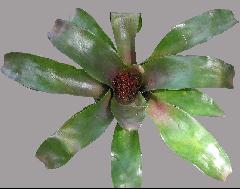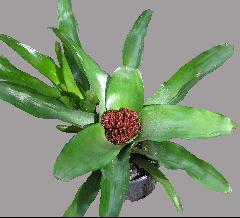

Unregistered. Photo D.Butcher. |
First let us look at the scenario. We know that an animal Mule or Hinny can have either non-functional male or non-functional female parts. In Bromeliaceae, things are a bit more complicated because most plants are monoecious ( both sexes in the same floral bed!).
But there are exceptions. Let us take Catopsis which Lyman Smith treated as either monoecious or dioecious ( functionally separate sexes) but Palaci has shown us that some species can be trioecious ( monoecious and dioecious!). This had me asking questions which have so far gone unanswered. If the seed producer was dioecious would the seedlings be 50/50 male/female or 1/3 : 1/3 : 1/3 male/female/perfect? Let us also look at Aechmea mariae-reginae which is said to be dioecious and yet in the mid 1800’s it seems a ‘perfect’ plant was painted and described! This is the sort of thing hybridists should be noting and commenting on.
Let us now look at bigenerics. We know that a generic hybrid has a lower pollen count which means that in the wild there is a greater chance of back-crossing with parental species in the vicinity. This does not happen with human intervention! A bigeneric hybrid would have even less pollen count and in many cases the sex parts are deformed. BUT are they functional either as ovule producers or pollen producers? This is also an area where hybridists seem shy to divulge findings. I have a feeling that even with a very low pollen count, fertilization can take place by backcrossing with parents involved in the same nothogenus.
Back to reality. In May 2009 when at Pine Grove Nursery in northern New South Wales, I was shown a plant that had Neoregelia ‘Lila’ x Neoregelia ‘Medusa’ on the label with the quaint note that this plant had bigeneric traits – AND it did. There was no intention of the hybridist Allan Ladd, to register his creation although willing to put plants on to the market. This attitude is prevalent amongst hybridists around the world, not just Australia, but a problem for the Cultivar Registrar. Many times has a discarded hybrid been considered a good plant and grown by many Bromeliad growers and had to be ‘grandfathered’ into the system.
Anyway, I was called in to adjudicate on a problem plant where the locals considered foreign pollen could well have been involved. The inflorescence was strongly compound. Why was it so? Luckily there was also a N. ‘Scarlet Charlotte’ x N. ‘Medusa’ which meant that the common denominator was N. ‘Medusa’ and luckily there was a plant of this name handy for me to butcher the inflorescence. I must now mention there are two sorts of Neoregelia ‘Medusa’ – one by Hendrix which has spines and one sold by Deroose that does not have spines. The plant was typical Neoregelia but the alleged non-spined form. It had the leaf deformity of piping you often see in the spineless Aechmea fasciata whose origin is shrouded in mystery, which suggested it was involved somewhere. This called for investigation. First Dennis Cathcart was able to advise that in their experience at Tropiflora this hybrid, when used as a parent, most times produced spineless progeny but never with compound inflorescence. The only real downside was the cracks and piping of the leaves which is exactly the problem with the spineless Aechmea fasciata. I suggested the possible involvement of this at bigeneric level to Reginald Deroose and his view was it was highly unlikely because, in his experience, bigenerics had malformed genitalia and could not be easily used in any further hybridising program. He said that they had first obtained the spineless ‘Meyendorffii’ from Germany from the Orchid people, Gunther Gemmel. Because the Orchid hybrid system is based on greges obtained from the quoting of true parentage I was optimistic in getting some positive reply. Alas, they do not keep records from that long ago. So we are left to conjecture. Was this oddity caused by mutation at seed level, mutation as a mericlone, or just plain sporting, or a hybrid with a compound inflorescence Neoregelia, OR WAS it a bigeneric and then backcrossed. Because Neoregelia does contain both compound and simple inflorescence species I tried to get some opinion from Neoregelia taxonomists. We know that some Aechmea species can flower either simple or compound so why not Neoregelia. No one was prepared to make a comment.
Clearly Neoregelia ‘Medusa’ (Deroose) has genes that link to piping and entire leaves but where does the compound inflorescence come from.
Because of the typical xNeomea inflorescence we are calling (Neoregelia ‘Lila’ x Neoregelia ‘Medusa’ ) = xNeomea ‘Mad Allan’ ( unreg) and (N. ‘Scarlet Charlotte’ x N. ‘Medusa’) = xNeomea ‘Scarlet Ladd’ (unreg)
Hybridist Allan Ladd and named by Ross Little.
By looking at the photos, both plants would be grown purely on the grounds of curiosity and would not constitute being in general circulation under the ICNCP rules. As such they will not be formally registered but strange happenings such as this should always be recorded.
If anyone is aware of similar happenings would you please advise the Registrar – Geoff Lawn – so that corrections can be made to the records. Are there any other ‘hidden’ xNeomea out there ?


Unregistered. Photo D.Butcher. |